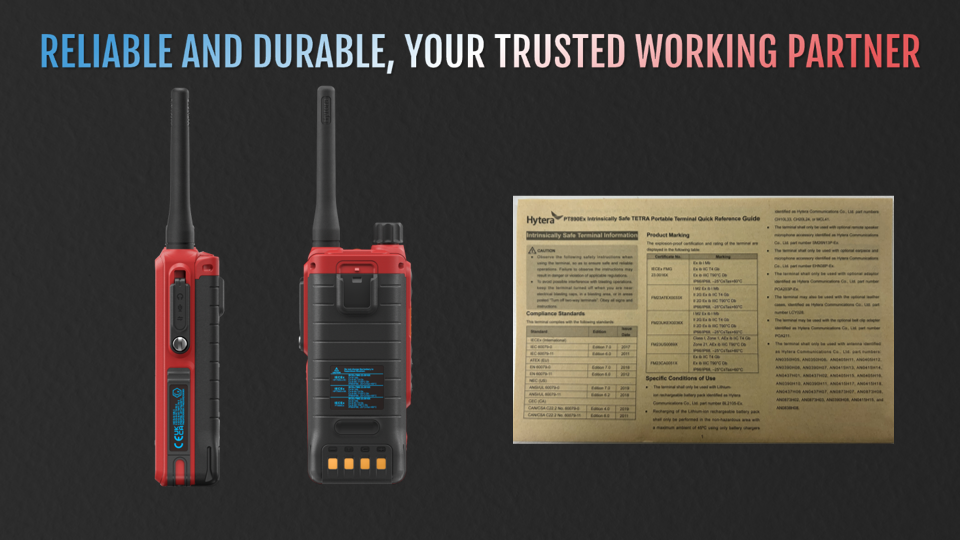Are There Explosion-Proof Certification Standards? Is It Safe?
Explosion-Proof Radio
In hazardous environments, two-way radios stand as an essential – crucial for work to move ahead safely. A reliable intrinsically safe two-way radio is of utmost importance.
This blog will guide you through understanding explosion-proof certifications, ensuring your equipment meets the highest safety standards for you and your team.

Main Explosion-Proof Certification Standards
ATEX Certification: ATEX (Atmosphères Explosibles) is a European Union directive regulating explosion-proof equipment used in explosive atmospheres. Devices must comply with ATEX standards to be legally sold and used in the EU. This certification ensures that equipment is designed to prevent ignition in flammable environments, safeguarding workers and facilities.
IECEx Certification: IECEx (International Electrotechnical Commission System for Certification to Standards Relating to Equipment for Use in Explosive Atmospheres) provides a global certification system for explosion-proof equipment. Recognized worldwide, IECEx certification makes it easier for manufacturers to market their products internationally. IECEx ensures that products meet stringent safety requirements, providing a high level of safety assurance across different regions.
UL and CSA Certifications: In North America, the leading certification authorities for intrinsically safe devices are UL (Underwriters Laboratories) and CSA (Canadian Standards Association). Both entities employ rigorous testing methodologies to guarantee that radios adhere to essential safety regulations, ensuring their reliability in hazardous environments.
Hazardous Area Classification
- Proper classification of hazardous areas is crucial for implementing effective safety measures. These classifications help in selecting appropriate explosion-proof equipment for different hazardous environments:
- Class I Division 1: Areas with continuous presence of ignitable concentrations of flammable gases or vapors.
- Zone 0: Areas with continuous explosive atmospheres.
- Zone 1: Areas where explosive atmospheres are likely during normal operation.
- Zone 2: Areas where explosive atmospheres are not likely during normal operation but may occur briefly.
Understanding these classifications aids in ensuring optimal safety by choosing the right explosion-proof equipment for each specific environment.
Gas Group Classifications and Dust Explosion Protection
Gas group classifications define the explosive characteristics of gases and vapors, critical for selecting suitable equipment:
Group I: Applies to mining environments.
Group II: Covers surface industries, with subdivisions such as:
- IIA: Propane.
- IIB: Ethylene.
- IIC: Hydrogen and Acetylene (most explosive).
Dust explosion protection involves different zones based on the presence of combustible dust:
- Zone 20: Continuous presence of combustible dust.
- Zone 21: Likely presence of combustible dust during normal operation.
- Zone 22: Unlikely presence of combustible dust during normal operation but possible under abnormal conditions.
Equipment in these environments must prevent dust accumulation and eliminate ignition sources to maintain safety. Selecting the right equipment based on these classifications ensures that the devices can safely operate under specific conditions, preventing potential explosions.

The More Certifications, The Better
Yes, in the case of explosion-proof certifications, more is better. Having multiple certification standards for a device typically means that the intrinsically safe two-way radio has undergone various rigorous tests and reviews, ensuring its safe operation in various hazardous environments. Different regions and countries may have different certification requirements. Having multiple certifications allows the equipment to be legally sold and used in a broader market. This is particularly beneficial for multinational corporations as it simplifies the compliance process.
How to Determine if Your Intrinsically Safe Two-Way Radio Meets Safety Standards
To ensure that your intrinsically safe two-way radio meets safety standards, follow these simple steps:
1. Check for Certification Marks
- Look for certification marks on the product, such as ATEX, IECEx, and FM.
2. Review Product Documentation
- Examine the product specifications or user manual to see if it mentions any relevant certifications.
3. Visit the Manufacturer's Website
- Head to the official website of the manufacturer to find information about product certifications.
4. Consult Sales Representatives
- Reach out to sales representatives or dealers and inquire whether the product meets specific certification standards.
By following these straightforward steps, you can quickly determine if your intrinsically safe two-way radio has the required certification standards.

Recommended Products
Hytera HP702 UL913 Intrinsically Safe DMR Portable Two-way Radio
The HP702 UL913 Intrinsically Safe DMR Portable Two-way Radio is a UL913, CSA and TIA4950 certified intrinsically safe radio. HP700 DMR digital explosion-proof radio is an intrinsically safe explosion-proof terminal specially designed by Hytera for energy and petrochemical, mining, fire emergency, airport and other industries. Provides safe, reliable and efficient communication services in harsh flammable and explosive environments.
Hytera HP79XEx IIC Intrinsically Safe DMR Portable Two-way Radio
The HP79XEx IIC Intrinsically Safe DMR Portable Two is an IECEX certified intrinsically safe radio.
HP79XEx IIC provides clear and loud voice quality, extended working hours, and long-distance communication capabilities. This design meets global explosion-proof certification standards, providing reliable safe communication for industries such as oil and gas, fire rescue, airports, manufacturing, and more.
Hytera PT890Ex Intrinsically Safe TETRA Portable Radio
PT890Ex intrinsically safe TETRA portable radio obtains the IECEx/ATEX certificates, to reduce the risk of accidents, and ensure the safety of users and operators. PT890Ex features a secure design, durable body, and advanced ergonomics. With a 2W high-power speaker, audio is loud and crystal-clear. PT890Ex has Class 3L transmission power, which expands coverage and allows key information to be received even in remote areas.





